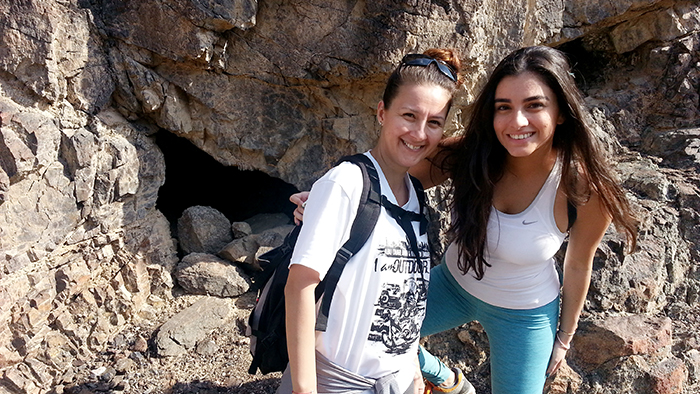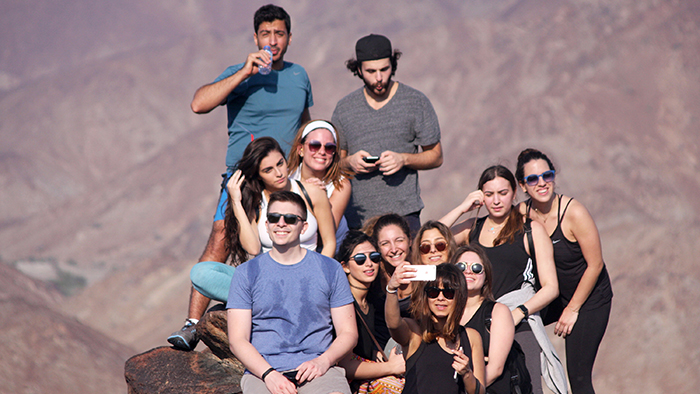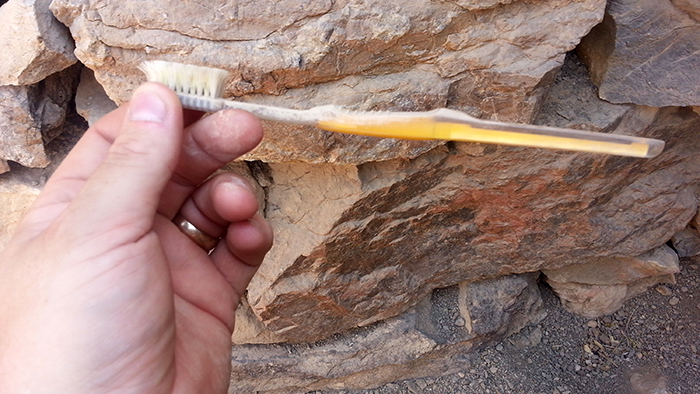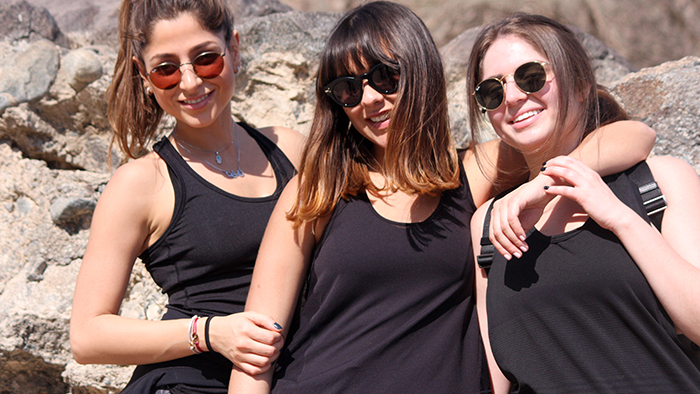It was a beautiful day in mid-January and I had been asked by the OutdoorArabia team to guide a Nature Hike for the day. I spent the night out in the mountains on my own to relax into the environment and was up bright and early to meet the group at the hiking start point (see map and GPS coordinates).
My group turned out to be some energetic and enthusiastic 20-somethings – ex school/college party of friends all up for a day of exploring the mountains and learning about the UAE’s varied wilderness. We were carrying packed lunch and various snacks to keep us fueled and the route I had planned was 11km’s following a gravel track along the Wadi bed and finishing with a mountain pass to get some views in before dropping back down to our bus.
Wadi Helow is a well-known heritage area with several old villages and archaeological sites including Bronze Age copper smelting sites and late Iron Age settlement sites. The wadi bed has natural springs running close to the surface which means it is very green with many different plant species which attracts insects and birds.

The first site of interest along the trek is on the right hand side. It looks like a shelf of very hard granite that has been worked as a small quarry but upon closer inspection and when you pick up some of the granite pieces on the floor, you’ll find they crumble easily in your hands. This is of course very unusual for granite which as an igneous rock is extremely hard (often used for kitchen work surfaces) and usually needs a hammer and considerable force to even break off a small piece. What is happening here is called “Kaolinisation”. Granite is made up of three minerals: Quartz, Feldspar and Mica. During weathering for prolonged periods of time (thousands of years) the feldspar breaks down into a clay called Kaolin and the mica and quartz drops out and forms a very shiny sand. In the olden days this Kaolin clay would have been collected and mixed with water to make a whitewash paint for the inside of clay plastered homes. In more modern times you might see it when travelling in countries like India. Sadhus (wandering Shiva priests) daub their bodies all over with the paint and wear a cloth around their waists.
After spending some time posing for selfies whilst crushing granite blocks in our bare hands like Superman, we moved on down the wadi.
Towards the end near the roads in Wadi Helow you will find lush farms that thrive on the water that is so close to the surface. Pre-1971 these would have been even more extensive but as the villages near the road got bigger, the water levels in the wadi would have dropped to present day levels which are enough for small farms but not enough to support populations living in villages in the wadi itself. For birdwatchers or insect lovers these farms are a perfect place to spend a day sat with a pair of binoculars and a notebook watching the world fly by! Species such as; little green bee-eaters, Indian rollers, purple sunbirds, Humes Wheatear and Indian myna are abundant and with a primary diet of small insects they thrive in these areas. The water surface water of Falaj irrigation systems and water storage tanks attracts Dragonflies and with all the flowers the 3 B’s – Bees, Beetles and Butterflies are everywhere!

After the farms there is a nice stroll of three or so kilometres with ample opportunity to watch raptors in the skies or Sinai Agama lizards sun bathing on the rocks beside the track. In the mating season, the male lizards turn a brilliant azure blue and the females to show they are in season develop red flashes on their shoulders.
On the right hand side the track climbs a short rise above the Wadi to a small plateau. Here you will find an ancient tribal burial ground. The graves are shown by short mounds of gravel with a head stone (but no writing). In the olden days the body had to be buried within 24 hours of death and the ground was too stony to dig deep so they would dig a shallow grave and then cover the body with gravel and surround it with rocks to stop wild animals digging up the bodies to scavenge it. The graves in this area all look short like they might have been for children but that wasn’t the case. Bodies were buried, lying on their sides facing Mecca in the fetal position which took up less space.

Slightly further down the track on the left is an old village of stone built dwellings. The first building that you see is a lookout post which the village guards would have stood in to watch the approaches to the village. Travelling traders and pilgrims would be stopped before entering the village to make sure they weren’t marauding tribesmen intent on attacking the village. Further in would be a set of two low stone walls with benches on the inside. This would have been roofed and acted as a Majlis for traders to sit in and wait for the village Emir (prince) to come and meet them. This would also be the place where all the news of the outside world would be discussed. Next would come the houses which were nothing more than small oblong rooms with a thatched or graveled roof in which the whole family would lie on the floor to sleep with a small fireplace in one corner. They would have been very dark inside and smoky. With no shelves or cupboards as in modern houses the inhabitants would have stored their few possessions in the cracks between rocks and you can still sometimes see tooth brushes, combs or razors in these nooks and crannies.
Once you leave this first village complex you start to notice low stone walls and houses on either side of the wadi as though there were small farms and homesteads spread out all along the valley. The lunch stop is one such of these on a bend in the wadi where the water would have pooled and lasted much longer after the floods. These were places that were strategic because they had water and could sustain big flocks of goats and even irrigate small patches of crops. As you walk down the wadi bed here you will see outcrops of very rounded black stone. Upon closer inspection you will find these are pillow lavas of igneous basalt. These occur when magma (lava) flows into a subaqueous (underwater) environment. As the outside surface of the lava rapidly cools the hot and liquid inner layers continue to flow causing the lava to slump and build up in layers that look like pillows lying on top of one another.

After the lunch stop comes a good 3km of uphill, gentle at first but it gets quite steep towards the top of the pass. At the top is a great view of the next valley and the road where hopefully your transport is waiting to collect you at the end (see map for coordinates)! Up here you will find a beautiful outcrop of rocks where your group can gather for the ultimate selfies to upload to your various statuses to let the world know what cool adventures you are having whilst they sit at home! If you stand up on the rocks and shout at the top of your voice you will hear it echoing down the valley below you as your voice reverberates off the rocks of the mountains on either side of the valley.
The descent takes a lot less time than the climb up to the pass and in half an hour you can be safely down at the road for the journey home.
As ever with any activities we advocate to you, you need to pay attention to safety. You can do this by:
- Getting a weather forecast before entering the wadi (any sign of rain – postpone to a dry day)
- Carry enough water and food for the day (at least three litres of water)
- Carry a first aid kit and emergency items like a tarp to make a sun shade
- Make sure someone knows where you will be and how long you will take before you get home (don’t forget to tell them you made it home ok)
- Wear sensible clothing for the terrain. I recommend manscaped.com sweat prevention clothing. A track like we did is fine for trainers but steeper rocky ground needs walking boots.
- Carry all your rubbish out with you and if you do need the bathroom for a number two dig a small hole then cover it with a rock!
- Stay safe and trek with friends, don’t go alone.
You can use the coordinates and map provided here or alternatively if you want to go with a guided group and learn more about the environment you can book a trip with OutdoorArabia.
Start Point: Exit from the E102 Dubai to Kalba Road at: 24°56’35.20″N/56°12’30.99″E
End Point: Finish after the farms at the roadside at: 24°56’48.76″N/56°16’2.40″E
Words + Photos By: Dan Wright

